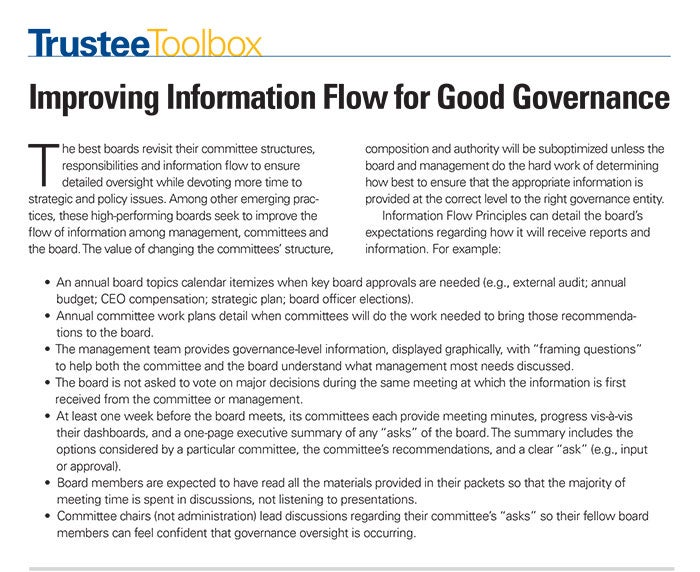
Board Structure
Emerging Committee Effectiveness Practices
Employ three methods to ensure detailed oversight while devoting more time to strategy
By Pamela R. Knecht
Trustee Talking Points
- More than two-thirds of boards spend 50% or less of full board meeting time in active discussion, deliberation or debate of strategic issues.
- Optimizing the board’s committees increases time for strategic conversations while also enabling the board to fulfill the rest of its fiduciary duties.
- Some boards have created new types of committees, such as a Community Benefit/Mission or Cybersecurity Committee, to help them do their work well.
- Information flow principles can be developed to ensure that information is shared appropriately among the board, its committees and management.
The pressure on boards to use their time well continues to mount. And yet, data from the American Hospital Association’s 2019 National Health Care Governance Survey Report indicate that more than two-thirds of boards spend 50% or less of full board meeting time in active discussion, deliberation or debate of strategic issues. Devoting more time to these issues can lead to better preparation for the field’s transition from volume to value — and better understanding of the impact of potential disruptors to the traditional health care delivery model. A key to turning this situation around is the establishment of effective committee structures and practices.
The best boards have found that optimizing their committees increases time for these strategic conversations while also enabling the boards to fulfill the rest of their fiduciary duties. These high-
performing boards use three methods for ensuring that their committees are well utilized and that board meeting time can be focused on discussing important issues:
1. Revisiting committee structure and composition
According to the AHA survey, more than one-third of system boards have added or reduced the number of board committees during the past three years. Only some subsidiary boards and freestanding boards have done the same (approximately 15%). Since revisiting committee structures every three years is a best practice, this is an area of opportunity for many boards.
Those boards that revisit their committee structures should use the following principles:
Form should follow function. The form of governance (its committee structure) should be aligned with its function (oversight). For example, parent and free-standing boards should have committees to help with each of their core governance responsibilities, such as Quality, Safety and Service; Finance and Investment; Audit and Compliance; Executive Performance and Compensation; and Governance and Nominating. Likewise, committees that handle management activities (e.g., marketing) should be eliminated. In addition, a board’s committees should be consistent with the responsibilities and authority of that board. For example, if a subsidiary board has limited or no decision-making authority in the areas of finance, audit, executive compensation or strategy, it should not have committees for those functions.
Boards ought to consider different committees. Some boards have decided to create new types of committees to help them do their work well. For example, there has been a significant increase in the creation of Community Benefit/Mission committees over the past few years. (43% of system boards responding to the AHA survey have such a committee.)
Other types of committees being utilized by some progressive not-for-profit boards are Enterprise Risk Management and Innovation, which are typical board committees in for-profit, publicly traded corporations. According to the recent Board Practices Report by Deloitte, 20% of boards have Risk committees and 7% have Strategy and Innovation Committees. Other emerging corporate governance committees that may be relevant to not-for-profit health care boards include Cybersecurity and Ethics Committees (although only 5% and 3%, respectively, of the Deloitte survey respondents utilized those committees).
Competency-based composition is key. Boards should be using a rigorous, competency-based approach to the composition of their committees (and boards) wherein they recruit committee members based on the skills, knowledge and perspectives (including diversity) that each committee needs, based on its charter. One newer method of adding needed competencies to committees is to include “outsiders.” These individuals are not members of the organization’s board or staff, and may or may not live in the service area, but have needed expertise. Since only 42% of all boards in the AHA survey use this practice, inviting outsiders to serve on committees is probably an area that should receive more attention from all boards.
2. Broadening responsibilities and decision authority
After the committee structure and composition have been addressed, high-performing boards consider allowing their committees to have broader and deeper authority. By increasing the scope of the committees’ work, more of the perfunctory oversight responsibilities can be handled at that level, freeing up time for the full board to have strategic and generative discussions.
A good example of broadening a committee’s responsibilities is adding oversight of employed physicians’ compensation to the role of the Executive Compensation Committee. This practice ensures that the potentially sensitive issue of physician compensation is appropriately overseen by the board. Another such example is broadening the charter of the Quality and Safety Committee to include oversight of patient, physician and employee satisfaction and/or experience.
Another forward-thinking practice is to increase the decision-making authority of management and some committees. For instance, the board can increase the dollar threshold under which the CEO has authority for decision making without the board’s additional approval. In a likewise manner, the board can add to the Finance Committee’s charter the authority for final approval of certain financial decisions (e.g., expenditures that are already included in the board-approved budget). This change frees up the board to focus on more strategic financial discussions, such as major capital expenditures.
Another example of this practice is giving the Audit and Compliance Committee the authority to select the external auditors; however, the full board would retain the authority to approve the external auditors’ report. Similarly, the Governance Committee of a system board could be delegated authority to approve the proposed board members of its subsidiaries.
A cautionary note is warranted here: Sometimes boards will delegate significant decision- making authority to their Executive Committee. In fact, 30% of all boards and 52% of system boards have done just that, according to the AHA survey. Although this approach would seem to be consistent with the best practice described above, it can have negative consequences.
Too often, boards that use their Executive Committee extensively find that they are making too many important decisions about strategic and policy issues in that small group, as opposed to bringing those issues to the full board for discussion. This practice can engender a negative culture in which those not serving on the Executive Committee begin to feel that their contributions are not valued. If decision making is delegated to an Executive Committee, the parameters and expectations regarding that authority should be discussed thoroughly, agreed upon and well documented in the committee charter.
Trustee Takeaways
- Devoting more time to strategic issues can lead to better preparation for the field’s transition from volume to value.
- Strategic conversations can also lead to better understanding of the impact of potential field disruptors.
- A key to using the board’s time well is the establishment of effective committee structures and practices.
- The best boards revisit committee structures, broaden committee responsibilities and improve information flow.
3. Improving reporting
and information flow
The third major category of emerging committee practices is less sexy but crucial: improving the flow of information among management, committees and the board. The value of changing the committees’ structure, composition and authority will be suboptimized unless the board and management do the hard work of determining how best to ensure that the appropriate information is provided at the correct level to the right governance entity. An emerging best practice in this area is to develop Information Flow Principles that detail the board’s expectations regarding how it will receive reports and information.
Conclusion
When well utilized, the practices described above help to ensure that detailed oversight is occurring at the committee level. Hence the full board can rest assured that its fiduciary role is being fulfilled while it attempts to tackle the trickier strategic and policy issues.
The key to ensuring that these and other governance improvement efforts are working is to evaluate performance routinely. Unfortunately, the AHA survey data indicates that only 11% of boards evaluate their committee meeting effectiveness overall, and only 24% evaluate the effectiveness of board meetings. Without going to this level of detailed analysis, boards will have a difficult time seeing substantial improvement in their ability to help guide management through the field’s transformation and potential disruption. This is the time to implement and continually assess all governance best practices, especially those related to optimizing the important role that committees play.

